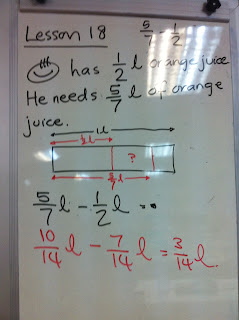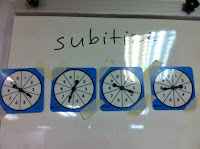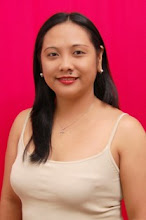31st August 2011
This was the last day of our Mathematics module. I felt very satisfied with my lecturer and I believe that not only me who gave an outstanding mark on the evaluation. After this module, I found myself very poor in analyzing some problems as I cannot make a correct word problem. I was so happy that in a short period of time I was able to think for my previous Mathematics class.
On the last day, we covered up mostly on the ways of assessment ( assessing procedure, assess conceptual knowledge, assess the method, practical test, paper and pencil and oral test). According to Dr. Yeap, some assessment can be individual and some assessment can be in a group.
I like the activity on which each group was asked to make a box that can fit 15 beans. It was really enjoying and I learned from it that eyes are really deceiving as we thought the small box that we made is perfectly fitted to 15 beans.
We had fun measuring the height and counting the steps of the staircase at Bras Basah MRT station.
Here's what we get:
Steps of the MRT staircase
3 flights of 16 steps
1 flight of 14 steps
each step is 15 cm.
Computation:
16x 3 = 48
48+14= 62
62x15cm= 930 cm
Saturday, 3 September 2011
Saturday, 27 August 2011
Session Five of EDU 330 Elementary Mathematics
26th August 2011
Thanks God it was the fifth day of our Mathematics class! On this session, we started with lesson 17.
Grouping Situation : 6 / 2 = 3
1/ 1/4 = 4 , 3/4 / 1/4 = 3

Thanks God it was the fifth day of our Mathematics class! On this session, we started with lesson 17.
Grouping Situation : 6 / 2 = 3
1/ 1/4 = 4 , 3/4 / 1/4 = 3
Note: a/b / x/y= a/x/b/y
In lesson 18, Dr.Yeap introduced a word problem

Spiral Approach : Get encounter same ideas again and again......
Bloom's Taxonomy: Describe the cognitive levels
( knowledge, comprehension, application, synthesis , evaluation)
Knowledge
What is the value of 5/7- 1/2
Comprehension
Is the word problem
Lesson 19 : Making squares out of the dot
In lesson 20, is a continuation of the shapes in connecting to the dot. There was a theory by George Pick other known as "Pick Theory" which is the area of figure is related to the dots on the side and inside.
Things to remember.....
- There are five transformation movement of shapes ( translate, reflect, rotate, stretch,shear)
- Polygons is a close figure
- There are symbols in comparing the are of square( units2, cm2,m2)
- The five uses of number ( cardinal, nominal, measurement, ordinal, represent proportion)
In lesson 21, we covered on the data representation which is making graphs. There are different types of graphs ( picture graph, bar graph, line graph, circle graph, pie graph)
The last lesson was on the Model Method
Example: 3/7 of the apples in a box are red apples . The rest are green apples.
There are 24 green apples
4 units = 24 apples
1 unit = 6 apples
24/4 = 6
Session Four of EDU 330 Elementary Mathematics
25th August 2011
This session had a good start for everyone as Dr. Yeap began the lesson with a magic tricks. The question is, Is it really a magic........ Oh! I was really glad to know this number trick that all you have to do is to look for the pattern to be able to guess the correct answer. I got 3 pegs on his first lesson as I am the one who found out the pattern hooray!!!!!!
In lesson 15, we covered a problem sum that taught different variation and a join situation. According to Zoltan Dienes
"Mathematics is not repetition they learn if you give them variation or the variant theory"
The next lesson which is lesson 16 was about naming the equal parts.
Some Acronyms I encountered which is helpful for me in learning the Primary Singapore System..
SRT - School Readiness Test
LSM - Learning Support in Mathematics
LSP - Learning Support Program
Thank you Dr. Yeap for a wonderful experience I had during your lessons. How I wish all the teachers in Philippines will be like you to help the children be more confident, competent and energetic in answering Mathematics and I hope you will come to my country to train Mathematics teachers.
This session had a good start for everyone as Dr. Yeap began the lesson with a magic tricks. The question is, Is it really a magic........ Oh! I was really glad to know this number trick that all you have to do is to look for the pattern to be able to guess the correct answer. I got 3 pegs on his first lesson as I am the one who found out the pattern hooray!!!!!!
In lesson 15, we covered a problem sum that taught different variation and a join situation. According to Zoltan Dienes
"Mathematics is not repetition they learn if you give them variation or the variant theory"
The next lesson which is lesson 16 was about naming the equal parts.
- I found out that the moment you have equal parts you can name the part.
- Being equal does not mean identical
- Fraction is a part of a whole
- Quantity is a part of a set.
- Same number can be named in different ways.
 |
| The moment you have equal part you can name it and this is one fourth. |
 |
| This shows an equal fraction |
 |
| This is an example of abstract |
Some Acronyms I encountered which is helpful for me in learning the Primary Singapore System..
SRT - School Readiness Test
LSM - Learning Support in Mathematics
LSP - Learning Support Program
Thank you Dr. Yeap for a wonderful experience I had during your lessons. How I wish all the teachers in Philippines will be like you to help the children be more confident, competent and energetic in answering Mathematics and I hope you will come to my country to train Mathematics teachers.
Session Three of EDU 330 Elementary Mathematics
24th August 2011
CASE STUDY
Session three was discussed by Miss Peggy Foo. We covered two case study in a pre-school setting that talks about the Factors of Good Mathematics Teaching Principles.
The content of the lesson was all about more or less and we tried to critique the teacher based on the video we had seen .
We came up with 5 different areas to see the effectiveness of the teacher.
 |
| These are the five areas Seating Arrangement Participation/Engagement Manipulative Classroom Management Flow /Sequence |
In Lesson Study, good teacher in Mathematics must check the following :
1. Seating Arrangement
2. Level of Engagement
3. Uses of materials
4. Flow/Sequence of Lesson
5. Classroom Management
6. Communication
7. Questioning skills
8. Attitudes /Disposition
9. Differentiation
In case study two, it was a good video showing an energetic teacher who helps the pupils to explore different options. Allowing children to think and apply what they have learnt in new situation by constructing different structures using a models with 3, 4 and 5 cubes.
Second Session of EDU 330 Elementary Mathematics
23rd August 2011
Another fruitful lessons we had on session two. We covered the lesson on the five key components ( generalization, communication, visualisation, number sense and metagcognition).
We also come up with a problem sum about John who spent 1/4 of his money on a gift and then he spent 1/3 of the remainder on a book . In this problem sum, it helps me to develop thinking skills as I was able to understand the idea of the problem and find the answer. It was really true that liking mathematics depends on the effective lecturer.
I have learnt a new mathematics term " subitize " which means something we just describe or unusual.
Another learning from session two was about the theory of Jerome Bruner.
C- oncrete
P- ictorial
A- abstract
This is what we called the CPA approach in learning . When we provide things like concrete materials , the children will be able to learn better by trial and error and has a deeper understanding how a certain things being arranged.
These are some of the interesting activities we did during session two.
Another fruitful lessons we had on session two. We covered the lesson on the five key components ( generalization, communication, visualisation, number sense and metagcognition).
We also come up with a problem sum about John who spent 1/4 of his money on a gift and then he spent 1/3 of the remainder on a book . In this problem sum, it helps me to develop thinking skills as I was able to understand the idea of the problem and find the answer. It was really true that liking mathematics depends on the effective lecturer.
I have learnt a new mathematics term " subitize " which means something we just describe or unusual.
Another learning from session two was about the theory of Jerome Bruner.
C- oncrete
P- ictorial
A- abstract
This is what we called the CPA approach in learning . When we provide things like concrete materials , the children will be able to learn better by trial and error and has a deeper understanding how a certain things being arranged.
These are some of the interesting activities we did during session two.
 |
| This is a game of picking the largest even numbers. |
 |
| This is a good game for a two players which they have to realize the bad and good number for them. |
Tuesday, 23 August 2011
First Lesson on EDU 330 Elementary Mathematics
Monday 22nd of August 2011
I was so amazed on the first day of my Elementary Mathematics class which I thought will be a boring night.... It was amazing that the lecturer did the lesson creatively, engaging and lot's of fun!
WHAT IS MATHEMATICS????????????
For me mathematics deals with number , shapes, problem solving , and equation.
According to MOE Syllabus ...............................
I was so amazed on the first day of my Elementary Mathematics class which I thought will be a boring night.... It was amazing that the lecturer did the lesson creatively, engaging and lot's of fun!
WHAT IS MATHEMATICS????????????
For me mathematics deals with number , shapes, problem solving , and equation.
According to MOE Syllabus ...............................
- Mathematics is an excellent vehicle for the development and improvement of a , person’s intellectual competence in logical reasoning, spatial visualisation, analysis and abstract thought.
- Students develop numeracy, reasoning, thinking skills, and problem solving skills through the learning and application of mathematics.
- Mathematics is also a subject of enjoyment and excitement, which offersstudents opportunities for creative work and moments of enlightenment and joy.
- When ideas are discovered and insights gained, students are spurred to pursuemathematics beyond the classroom wall.
Just to share with you ....
How numbers are used differently
1. Cardinal number- represent the number of objects ex: flower, cookies etc...
2. Ordinal number- refers to the position of an object
ex: 1st, 2nd , 3rd, 4th and so on....
3. Nominal number- It used to label example : bus 14
4. Measurement- it is used to measure numbers that can be standard or non-standard
unit of measurement.
What is a meaningful counting?
one to one correspondence
ability to classify and sort
ability to rote count
the last number that is uttered represent the number.
I am very eager to come for the next session as it was fun and exciting class!!!!!!!
Tuesday, 16 August 2011
Reflection on pre-course readings
I've been a teacher for more than a decade but have not experience teaching mathematics to young learners. As I was reading this book, it gives me the courage to teach mathematics. I found out that knowledge of mathematics and how students learn mathematics are the most important tools that I can acquire to be an effective mathematics educator. Honestly, I am a person who really hates mathematics during primary school , but this attitude change when I met my algebra teacher. She was really compassionate and willing to teach me until I grasped the concept of it. In this experience, I can relate myself to other students who also hated mathematics. If the teacher is able to find ways and strategies to help them learn I think most of the students will love mathematics.
There are principles and standards that has been designed for teachers as guide and direction in teaching this subject released by the (NCTM) or National Council of Teachers of Mathematics. These principles and standards will help me and other beginners in teaching mathematics.
There are many ways to develop children's understanding on the different concepts like using models and manipulative to support their learning.
I was looking forward that at the end of this module, I will be able to teach mathematics and use the knowledge and strategies I will learn. Teaching mathematics will be a new great experience for me as an educator but I have to do something to become an effective mathematics teacher. Attending training, reading mathematics articles, continuous learning and perseverance will be my keys to be a mathematics educator.
There are principles and standards that has been designed for teachers as guide and direction in teaching this subject released by the (NCTM) or National Council of Teachers of Mathematics. These principles and standards will help me and other beginners in teaching mathematics.
There are many ways to develop children's understanding on the different concepts like using models and manipulative to support their learning.
I was looking forward that at the end of this module, I will be able to teach mathematics and use the knowledge and strategies I will learn. Teaching mathematics will be a new great experience for me as an educator but I have to do something to become an effective mathematics teacher. Attending training, reading mathematics articles, continuous learning and perseverance will be my keys to be a mathematics educator.
Subscribe to:
Comments (Atom)





